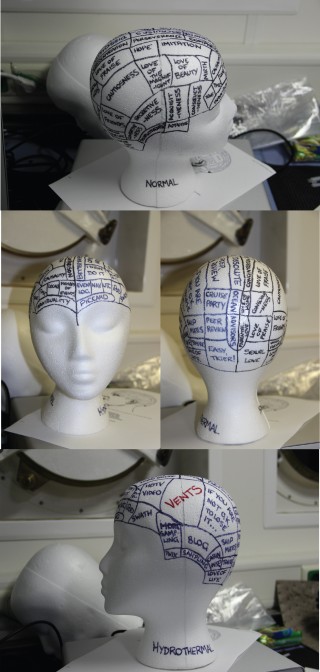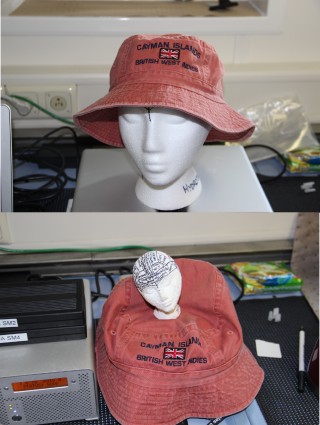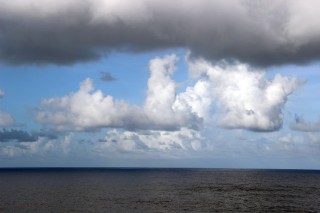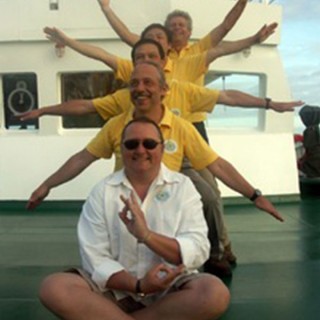
Saturday June 29th was an epic day. Also among the 4 top traumatic experiences I have ever had at sea with a robot. (All of which have come in the past 8 years!)
Our dive started beautifully as we landed near the Hot Chimlets vents and set to work collecting microbes attached to a rock from the “Furry Walls” site just above Hot Chimlet on the way to the Beebe Vents. Shortly thereafter we were settled out at the base of Beebe Vent 4 and ready to start work when we started having concerns – the cameras were glitching and suggesting our fiber-optic cable might be on the limit of failing at any moment.
Since today was our one and only chance to get a further set of samples with Chip Breier’s SUPR sampler, rising up in the plume above the Beebe Vents, we needed to press on without delay. We checked the temperature of the vents (still close to 400°C) and then lifted the sampler up above the mouth of the vent to a spot where it was only measuring 100°C so that we could start drawing water up the metal snorkel and into the plastic hose that feeds to the SUPR sampler’s sample-holders. Then, suddenly – disaster! Actually, just disaster part 1. The temperature sensor suddenly recorded values that climbed past 100°C and Jeff called out “270” just as we saw the plastic of the SUPR inlet melt away cleanly right at the metal-plastic join and flop away from where the sampler was being held. Dang!
We responded fast. Realizing that the sampler’s T-probe was now of little use to us, but that the input to the SUPR sampler was sticking away from the wrist of Nereus’ manipulator claw, we worked out a way to haveNereus point its elbow toward the plume at multiple heights off bottom as we rose up in the plume so that Chip could get his samples. With the main electronics component in Nereus’ hand, held over the sample basket and the SUPR-hose pointing out into space ahead of the basket, we rose slowly and steadily up through the plume, following it up to 100m above the seabed and still in billowing black smoker material the whole way. Very cool.

Next, it was time to go to our 2nd and last stop of the dive – the Beebe Woods site which is quite beautiful: I was really looking forward to it. Sadly, we never got there. In pursuit of fluid samples for Jill and shrimp for Max and Cindy, we set off to the South and had just 40m to go as we climbed uphill when we suddenly noticed bright yellow cable running uphill ahead of us on the left. But then we noticed that the cable didn’t lie entirely along the seafloor but lifted off bottom as it disappeared out of sight back behind us to the left – exactly the way in which we had just come. Draped over some overhang like a washing line, we had driven up underneath the cable and had now become entangled with it round one of our propellers and were snagged. Like I said at the top of the page – traumatic. Pretty soon we had the entire Nereus team gathered in the Science Control van working out what to do next while I quietly ushered the science team into the library where they could watch proceedings but leave the engineers alone to figure things out. We didn’t keep the microphone on for the web-feed for all of their discussions.
While Chris called the Yokosuka to discuss what else the team might be able to glean about the cable from their Shinkai counterparts, and James and Jon ran calculations on whatNereus’ maximum capabilities might be, should the need arise (and for how long, given that we were on batteries), Andy and Casey talked through options sitting next to me. Happily, Casey found that he was at least able to break through the length of cable running uphill ahead of us so we didn’t have all that connected to us. But how much was attached behind us, and where?
After some careful considerations – right down to Casey remembering which way he had each propeller working when we first saw the cable, Casey was able to move us as best he could without using the rear port thruster and then even spinning the propeller in the reverse direction. Somehow, all came good and we found ourselves up, 5m above the depth where we were first entangled with no yellow cables in sight and all thrusters working correctly.

Knowing how to appreciate good fortune, we turned our vehicle to point due West, out into deep water and away from the Beebe Woods site and bravely ran away. Having to go out into deep water we then drove north, keeping well clear of the Beebe Vents mound too (so we didn’t drive back over our own cable) and then circled all the way around to the East and then South to find ourselves at the Beebe Sea mound. Two hours after the vehicle first became entangled but 2 hours before we had to leave the seafloor, I had managed to guide us to a location called Shrimp Gulley where Jill could still get good samples for her PhD thesis work and Max and Cindy could get their shrimp.
And, ideally, I would also be able to get some nice HD video footage from this site – something we spectacularly failed to do in 2012. Phew. So we started with the first sampler and got what we hoped would be one good samples (we found out later that it wasn’t) and then we tried to take another and it was proving tricky to get such hot temperature readings but, with now just one hour left to go – and the Captain coming to the Control Room to advise that our weather was deteriorating fast – I told Jeff we just had to take the best sample we could, now.
Lucky that I did. 2 minutes later, with the sampler still in Nereus’ manipulator’s grip but over the basket, preparing to be put away, all our video screens went dead. Our fiber optic cable had had enough and it was time to come home: fluids intact but no shrimp and (still) no dedicated HD video imagery. Suddenly the dive was done, the science program (all but 1 more CTD cast and some swath bathymetry overnight) was done, and I could relax. So that is when, in my case, the headaches always start. Throughout the afternoon I have been feeling like parts of my brain are collapsing in on me. Funnily enough, I have a way to illustrate what that looks like.
A long-standing tradition in deep sea research is to take white polystyrene cups, decorate them, then attach them to anything headed to the deep ocean so that, when they come back, you can see how much they have collapsed in on themselves. But what I have always thought was really cool was the few examples I have ever seen of a collapsed polystyrene head – the kinds used in stores to model wigs or hats. Happily, Leighton had a stash of these and had shared one with me, the night before our last dive.
Faced with a 2 hour wait one recent evening while Casey and the team wrestled with our HD cameras, which would either work or not meaning, in turn, we would either dive or not, I needed something to distract myself. So I turned to thinking about how to decorate the blank “head” in front of me. Remembering the present we had bought by brother-in-law Ian when he turned 40, I researched phrenology on-line and down-loaded an image of the 19th Century drawings showing how some, at the time, thought the human brain worked. So far so good – that gave me the raw material for how to decorate the right side of the brain. But what about the left? Suddenly inspiration struck: One side could be “Normal” the other “Hydrothermal”. Put the two together, deploy to 5000m, and see what results.
Happily, Cliff made the following reassuring observation after we got my shrunken head back. As well as no longer being such a big head, he also noted that I was now “tilting more toward normal than before”. It must be time to go home!

